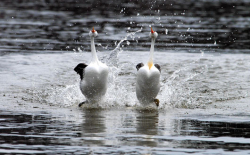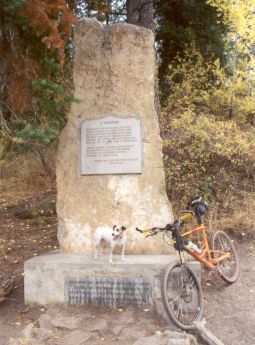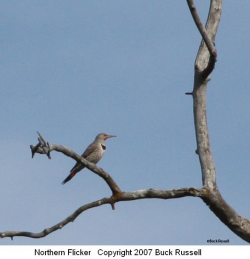
Courtesy US FWS
Dave Menke, Photographer
These two Mallard-sized grebes look nearly identical, with long white necks like a swan’s and lance-shaped bills like a heron’s. They differ subtly in the color of that bill and the extent of their black caps. What is most striking about western and Clark’s grebes is not their dapper appearance but their exuberant courtship dance. Like Snoopy dancing beside his mirror image, a pair of birds will tread furiously across the water surface, enabling them to rise upright with their necks stretched forward. After skittering ahead for 20 feet or more, the couple abruptly pitches forward and dives beneath the surface.
On our lakes and marshes, these two species of grebes today make the biggest splash on their watery dance floor. Just a century ago, they were hunted to near extinction for feathers to adorn womens’ hats. Happily, conservation trumped fashion, and populations of both species have largely recovered. Can any North American waterfowl match the vigor of this foot-churning courtship display? You be the judge. Pull up a lakeside seat, and with a little luck, you will be in the audience when they dance their splashy quick-steps to the primordial cadence of spring.
Credits:
Photo: Courtesy US FWS, Dave Menke Photographer
Text: Bridgerland Audubon Society: Jim Cane Bridgerland Audubon Society
Voice: Richard (Dick) Hurren, Bridgerland Audubon Society
For More Information:
Check out Grebe Video on Google
Western Grebe Identification, All About Birds, The Cornell Lab of Ornithology, https://www.allaboutbirds.org/guide/Western_Grebe/id
Clark’s Grebe Identification, All About Birds, The Cornell Lab of Ornithology, https://www.allaboutbirds.org/guide/Clarks_Grebe/id
Western Grebe, Guide to North American Birds, Audubon, https://www.audubon.org/field-guide/bird/western-grebe
Clark’s Grebe, Guide to North American Birds, Audubon, https://www.audubon.org/field-guide/bird/clarks-grebe
Western Grebe, Birds of the World, The Cornell Lab of Ornithology, https://birdsoftheworld.org/bow/species/wesgre/cur/introduction
Clark’s Grebe, Birds of the World, The Cornell Lab of Ornithology, https://birdsoftheworld.org/bow/species/clagre/cur/introduction
Western Grebe, UtahBirds.org, https://www.utahbirds.org/birdsofutah/ProfilesS-Z/WesternGrebe.htm
Clark’s Grebe, UtahBirds.org, https://www.utahbirds.org/birdsofutah/Profiles/ClarksGrebe.htm



